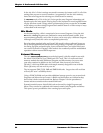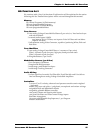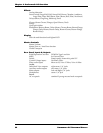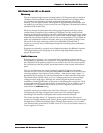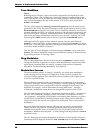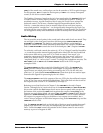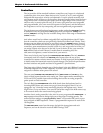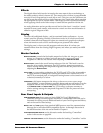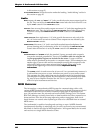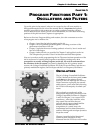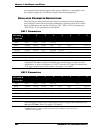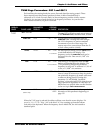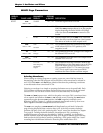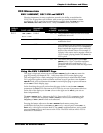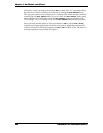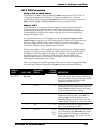
Chapter 4: Andromeda A6 Overview
102 ANDROMEDA A6 REFERENCE MANUAL
in this section on page 95.
FILTER AUDIO INPUTS: see the discussion under the heading “Audio Mixing” earlier in
this section on page 95.
Audio
MAIN outputs: the LEFT and RIGHT 1/4” jacks provide the main stereo output signal for
the A6. They are fed by the
MASTER VOLUME control after the final voice mix is set
by the
LEVEL control in the VOICE MIX section.
AUX OUT: these two auxiliary audio outputs are mono 1/4” jacks that supplement the
MAIN stereo outs. They are fed by the MASTER VOLUME control after the auxiliary
voice mix is set by the
MAIN/AUX SWITCH and LEVEL controls in the VOICE MIX
section.
VOICE OUTPUTS: these eight stereo 1/4” jacks provide the means to mix each of the
A6’s 16 Voices on its own mixer channel. These outputs are not affected by the
MASTER VOLUME controls.
HEADPHONES: this stereo 1/4” jack is used with standard stereo headphones for
private listening and/or monitoring of the A6. It is fed by the
MASTER VOLUME
control after the final mix is set by the LEVEL control in the VOICE MIX section.
Power
AC RECEPTACLE and POWER switch: the standard 3-prong recessed male receptacle
accepts the standard grounded AC line cord. A suitable cable for using the A6
in your geographical region was included in the carton. Longer or shorter
cables may be purchased at electronics or computer stores. Do not attempt to use
another type of power cable and do not attempt to modify this receptacle or the
cable itself. Doing so may cause serious injury or death. Please refer to the
chapter at the beginning of this manual entitled
Important Safety
Instructions
.
The
POWER switch is used to turn the A6 on or off. As a precautionary measure, it
is advised that you power on your A6 before you power on your audio system.
This prevents any audio spikes that may be output from the A6 from damaging
your amplifier or speaker system. By the same token, when shutting down your
rig, turn off your amplifier first then the A6. This is a good practice to follow
with all of your instruments and devices.
MIDI OVERVIEW
The A6 employs a comprehensive MIDI system for communicating with a wide
variety of MIDI instruments and devices. Unlike many keyboard instruments, the A6
offers MIDI control that you wouldn’t normally expect from an instrument of its
type. Of particular note, the A6 sends and receives MIDI Timing Clock. This System
Real-Time Message is usually found only on time-based devices like a sequencer or a
drum machine. Since the A6 has step sequencing and an arpeggiator, these clock-
based features can control other rhythm-type units or be controlled from an external
MIDI source.
The Andromeda is capable of sending and receiving on up to 16 MIDI channels
simultaneously (but keep in mind that only 16 voices can sound at any one moment).
Mix Mode is used for this kind of MIDI application. In Program Mode, the A6 sends
and receives on a single MIDI channel at a time.



